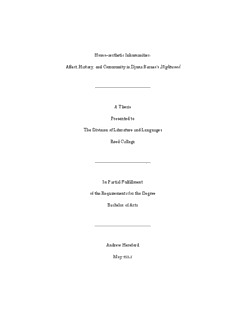
Homo-aesthetic Inhumanities: Affect, History, and Community in Djuna Barnes's Nightwood PDF
Preview Homo-aesthetic Inhumanities: Affect, History, and Community in Djuna Barnes's Nightwood
Homo-aesthetic Inhumanities: Affect, History, and Community in Djuna Barnes’s Nightwood A Thesis Presented to The Division of Literature and Languages Reed College In Partial Fulfillment of the Requirements for the Degree Bachelor of Arts Andrew Hereford May 2013 Approved for the Division (English) Jay Dickson Acknowledgments There is no further feeling of the pleasure of company than when one is most alone. This is what I have discovered in the writing of this thesis. Therefore, though I wrote a great deal of it in withdrawal, both unintended and created, I have a great many thanks to make. First, my interminable gratitude goes to my advisor Jay Dickson, without whom this thesis would not have been possible. The first instances of what has become this project were the discussions I had with and the papers I wrote for him while taking his course on modernism and the British novel. I want to sincerely thank him for his constant support and productive feedback, and for putting up, in his own gracious way, with my admittedly frustrating style of work. It is because of his encouragement and passion that I see this thesis, not as an end to be lamented, but as the beginning of an invigorating academic career. I look forward to meeting him again somewhere along the line. And to all of the other professors who have given me, whether directly or circuitously, the fervor I have for my intellectual work: to Kris Cohen, Ann Delehanty, Becky Gordon, Maureen Harkin, Hugh Hochman, Robert Knapp, Charlene Makley, Luc Monnin, Bill Ray, Pancho Savery, and Michael Taylor. I am also indebted to the Eddings Opportunity Grant for English Majors at Reed College for funding the research I did in developing this project. To my mother and my father, I am so very fortunate to have your love and support. To all of my friends, I count myself in nothing else so happy—to embrace words—as in a soul remembering you. I would particularly like to thank: Patrick Lyons, in whose brilliance it has been my pleasure to bask, and whose self-sacrificing friendship I could not have made it without; Nick Irvin, whose quiet virtuosity I can only but fail to live up to, and who was always there when my caustic bitchiness needed a fellow pair of eyes; Cora Walters, to whom I could always turn when I needed a bit of unrelenting warmth; Andrew Pritzkau, who has been with me since the beginning and who will be there until the end; and Janelle White, whose recent absence in my life has not attenuated my love for her. … And to my pink narcissus, never have I made a more beautiful world than with you. Table of Contents Introduction. Headways: Nightwood & Queer Thought ............................................. 1 Nightwood as Minor Literature ...................................................................................... 2 T. S. Eliot, Affect, and Impersonality ............................................................................ 4 Affect/History/Queer: A Methodology for Reading .................................................... 7 Schizoanalysis, Psychoanalysis, and the Intermezzo .................................................... 10 Chapter One. “History at night”: Affective Relationality .......................................... 13 Introduction .................................................................................................................. 13 History Without Affect: Several Inadequacies ............................................................ 18 Sodom/Gomorrah: Affective History, Queer Relations .............................................. 32 Chapter Two. Love’s Becomings .................................................................................... 43 Introduction .................................................................................................................. 43 The Possessed: Becoming-Animal as a Theory of Love .............................................. 45 Is Writing Inhuman?: An Emerging Love .................................................................. 62 Chapter Three. Narcissistic Aesthetics (Reflections on Subjectivity & Art) ........... 71 Introduction .................................................................................................................. 71 Impersonal Narcissism and the Aesthetic Subject (Reflection 1) ................................ 77 The Great (Aesthetic) Bed: Communities of Incest (Reflection 2) .............................. 94 Conclusion. An Appealing Community ....................................................................... 113 Appendix. Plot Summary of Nightwood .................................................................... 119 Bibliography. .................................................................................................................. 123 Abstract This thesis argues that Djuna Barnes’s Nightwood (1936) demands a reconsideration of current queer theoretical paradigms, not by rejecting or discrediting these paradigms, but by insisting that thought, by its very nature, lives in the intermediacy of critical practice; it uses community as the point of departure for thinking through and between issues of queer belonging, becoming, and relating. The first chapter argues that Nightwood outlines a framework of historical affectivity as the basis for queer community in which we necessarily encounter the past as enacted upon the body in moments of negative or depraved affect. In turning to the work of Gilles Deleuze and Félix Guattari, the second chapter develops this in order to show that a modality of ethical engagement emerges within the novel in which inhumanity is queerly reestablished as the basis of relationality in general. Love—both as a mode of becoming that tends toward the nonhuman and as an instance of writing—will be my name for this relation. Chapter Three then abruptly turns to the work of Leo Bersani and Ulysse Dutoit. In so doing, it argues that Nightwood promotes a version of narcissism in which the subject continually reaches beyond itself to find inaccurate replications of its own being, thus producing a virtual community of aesthetic associations. This thesis, therefore, sees within Nightwood (and in the critical conversation it posits between Deleuze & Guattari and Bersani & Dutoit) a possibility for the improbable task of queer thought—a possibility that connects us, in art, to the impossibility of our mutual existence.
Description: